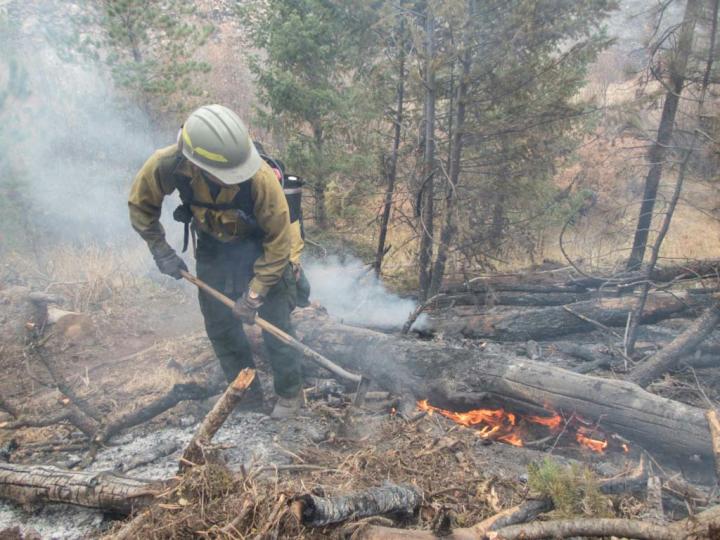With wildfire season in full swing, a COVID-19 outbreak at a traditional large fire camp is a potential disaster. A transient, high-density workforce of firefighters and volunteers responds to blazes while staying in close quarters with limited hygiene – conditions that could facilitate the spread of a contagious respiratory disease.
To support fire agencies as they continue their mission-critical work, a team that includes Colorado State University experts has developed an epidemiological modeling exercise for the USDA Forest Service and other fire managers that demonstrates potential risks and various scenarios COVID-19 could pose for the fire management community. Their model is published in the journal Fire.
The report is co-authored by Jude Bayham, assistant professor in the CSU Department of Agricultural and Resource Economics; and Erin Belval, research scientist in the CSU Department of Forest and Rangeland Stewardship; with first author Matthew P. Thompson, Research Forester at the USDA Forest Service Rocky Mountain Research Station. Bayham and Belval worked with Thompson on the study under a longstanding joint venture agreement with the Forest Service on wildfire-related research, which primarily operates through a partnership with the Warner College of Natural Resources. Thompson serves as the team’s liaison to the fire management community.
The researchers developed a simulation model of COVID-19 in the context of a wildfire incident in which the population of firefighters changes over time. The team then analyzed a range of scenarios with different infection transmission rates, percentages of arriving workers who are infected, and fatality rates.
They applied their model to real firefighter population data from three recent wildfires – Highline, Lolo Peak and Tank Hollow – to illustrate potential outbreak dynamics.
During the Highline fire in Idaho, for example, which at its peak had over 1,000 firefighters on site (See Figure 1.), a worst-case scenario would have seen close to 500 infections, and a best-case scenario of eight infections. (See Figure 7.) The researchers used a variety of infection fatality rates to estimate possible deaths due to COVID-19 on the fires, ranging from a low of 0.1% to an “extreme” of 2%, with a medium, or best-guess, of 0.3%. (See Table 1.)
Model is not a prediction
Like most modeling exercises, the report is not intended to predict real numbers; rather, it is a tool for comparing different scenarios and analyzing how various interventions could have small or large effects.
“There is a need in the modeling community to better communicate what we can and cannot learn from models,” Bayham said. “The model itself is not meant to be predictive in the sense of number of cases or deaths, because there are so many things moving.”
Bayham said the model does provide insight into the relative benefits of two risk-mitigation strategies: screening; and implementing social distancing measures at camps.
They found that aggressive screening as soon as firefighters arrive at camp could reduce the spread of infection, but those benefits diminish as a wildfire incident goes on longer. For longer campaigns lasting several months, aggressive social distancing measures, including increased use of remote briefings, dispersed sleeping camps, and operating under the “module as one” concept, would be more effective at reducing infections than screening. “Module as one” is a social distancing adaptation in which a crew operates mostly as normal but isolates from other, similarly isolating crews.
“It all comes down to exposure, which is a basic risk management concept,” Thompson said. “Reducing the exposure of susceptible individuals to those who may be infectious is the idea behind screening and social distancing. Our results underscore the importance of deploying these risk mitigation measures and provide insights into how characteristics of a wildfire incident factor into the effectiveness of these mitigations.”
Bayham added, “Both interventions are useful, and they both have an effect, but they each have times and places where they are even more effective,”
Such findings could help inform the wildland fire management community as it develops guidance for fire response strategies during the pandemic.
Thompson added, “I’m fortunate to have worked with Jude and Erin for several years now, and in my opinion their collective depth and breadth of expertise is uniquely well suited to address this complex issue. We’re grateful for the support from the Joint Fire Science Program and more broadly the fire management community to continue this important work.”
Extending the work
The team will continue their work with a $74,200 award from the Joint Fire Science Program by way of the USDA Forest Service Rocky Mountain Research Station joint venture agreement. They plan to extend their model and create an interactive dashboard for agencies to provide real-time modeling and risk assessment support as fire season continues.
They are also working on a model that would be better suited to analyze season-long implications of COVID-19 outbreaks, spread across multiple fires and geographic distances.
###




































